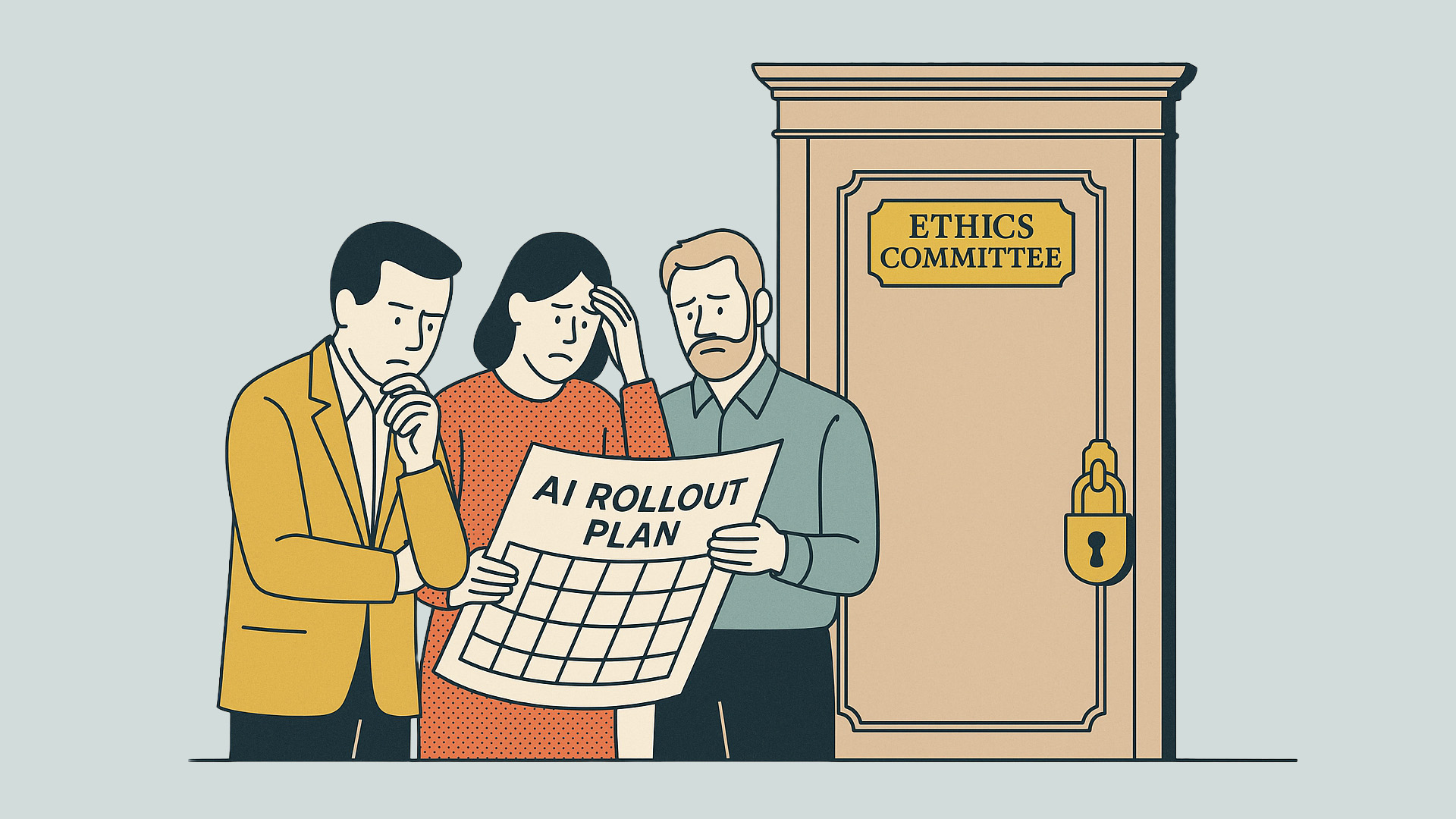

Find your next executive




Find your next executive
Find your next executive



Let’s address the elephant in the boardroom: the hype around AI ethics is outpacing actual AI execution in most companies.
We’re seeing a wave of companies debating the need for ethics boards, philosophical frameworks, and "AI principles" — while they still haven’t implemented a single high-leverage AI workflow in finance, support, sales, or product.
And in private settings, here’s what leaders are saying:
“Do we really need an AI ethics committee?”
“Are we exposed if we roll this out without one?”
“Will this slow us down?”
Let’s be clear:
You don’t need an AI ethics committee.
You need clarity, transparency, and ownership.
In theory, AI ethics boards sound noble: independent oversight, responsible deployment, cross-functional collaboration.
But in reality, most "ethics" initiatives inside startups and growth companies fall into three categories:
And meanwhile?
Sales teams are underperforming. Support queues are backed up. Marketing is slow. Finance is inefficient. Product velocity is lagging.
The opportunity cost of waiting for perfect ethical clarity is enormous.
Let’s be responsible here. There are real use cases where governance matters deeply:
In these areas, yes — ethics oversight is critical. Bias, harm, and systemic inequality are real risks.
But if you’re a B2B SaaS company using AI to generate outbound, summarize support tickets, write marketing copy, or improve productivity?
You don’t need an ethics board.
You need a workflow strategy.
Instead of debating hypotheticals, leaders should focus on the real operational risks:
AI-generated content that contains factual errors or misleading claims — especially in regulated or customer-facing content.
✅ Solution: Establish approval workflows, human-in-the-loop editing, and legal guardrails where necessary.
Overuse of AI in content creation can make brands feel bland, repetitive, and robotic.
✅ Solution: Maintain a sharp, human-led brand tone and creative point of view. Use AI for speed, not voice.
Teams pasting proprietary data into public tools like ChatGPT without understanding security implications.
✅ Solution: Train teams on privacy, roll out enterprise-level tools with clear usage policies, and restrict open data pasting.
Employees worry AI will replace them. Others think it's hype. Adoption stalls.
✅ Solution: Be clear: AI is here to augment, not replace. Train and enable. Reward AI-powered performance.
Everyone assumes someone else is thinking about AI risk. No one is measuring impact.
✅ Solution: Assign a clear internal owner. Tie KPIs to AI leverage and implementation. Include legal only where necessary.
You don’t need a 12-page Responsible AI Manifesto.
You need 5 clear internal principles for how AI is used inside your business:
We use AI to speed up, enhance, or scale the work of great people — not to automate judgment or empathy.
Whether it's a customer email, financial model, or candidate outreach — a person owns it. AI is the draft, not the decision.
We don't input proprietary or sensitive data into public tools. Enterprise tools are used where possible. Usage is logged.
We implement AI where it creates measurable lift — not where it’s trendy. Every AI tool or workflow must prove ROI.
We don't wait for philosophical consensus. We roll out AI in small, safe iterations — and adapt based on results.
You can build responsible AI oversight into your existing structure without standing up a new board.
Here’s how:
This is operational rigor, not ethical paralysis.
If you want customers and employees to trust how you use AI, focus on:
You don’t need a committee to do this. You just need intentional leadership.
“Should we build an AI ethics board?”
Only if you’re working in a frontier space or regulated environment. For most companies: no.
“Are we legally exposed if we don’t?”
Not today, and likely not soon. Just make sure your customer-facing content, legal documents, and data workflows are human-approved.
“Will our customers care?”
They’ll care if you mess up. But they won’t care how many committees you have. They care that you’re fast, safe, and clear.
“Should we pause until we figure it out?”
Absolutely not. Move forward with responsible boundaries. Pausing is how you lose to competitors who already built leverage.
The best operators we’ve seen are:
They’re not debating philosophy. They’re building advantage — responsibly.
AI ethics is not about theory. It’s about trust, performance, and accountability.
If you're building software to guide military drones, ethics committees make sense.
But if you’re using ChatGPT to help your sales team write better emails?
You don’t need a board.
You need ownership.
You need clear usage guardrails.
You need a culture of responsible experimentation.
And above all, you need to move.
The only thing more irresponsible than moving too fast on AI — is moving too slow while your competitors lap you with leverage.
Sources & Data:

